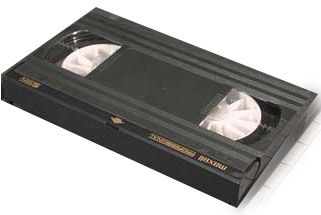|
Video
Recording >
Formats
> VHS
Specific
Formats
The following pages are a rundown of the recording formats
you are likely to run across in the forseeable future.
This gets technical, but it’s necessary knowledge.
I have excluded the more exotic formats and focused
on the ones you are most likely to encounter.
VHS
Image quality: poor
Generation
loss: Yes. Even 2nd generation copies look poor.
Recording
method: Composite
Digital
or Analog: Analog
Other
incarnations: S-VHS (Somewhat better picture); VHS-C
(Smaller Cassette)
Uses:
VHS, despite its shortcomings, is the primary videotape
distribution format for consumers (although not for
much longer. VHS is a quickly dying format--most people
prefer the higher quality of DVDs). All those tapes
you rent at Blockbuster use the VHS format. It’s
everywhere and that is its strength. S-VHS is
used as a production format in some lower-end settings.
A
lot of people get confused by VHS-C. It's just
a regular VHS tape with the sides chopped off. This
smaller version allows manufacturers to make a smaller
camcorder. Then you need an adapter to make it play
in a regular VHS VCR. It’s a silly solution, really.
|

VHS
is the best-known format--because
eveyone has a VHS machine at home.
But the picture quality is not sufficient
for program production.

|
|
|
|